Building a Paver Patio – Part 1
Building A Paver Patio – Part 1
Ever since we’ve move into this house (15 months ago), we’ve wanted a fire pit and paver patio. The backyard had a generous sized deck, a playset for the kids, and some old raised garden beds but no place for a fire pit. Our last house we had a concrete patio and then a fieldstone fire pit further out in the yard. It was a great place for friends and family to gather and enjoy each other’s company. I had been thinking about doing it for sometime but needed that last little push to actually do it. When Sakrete contacted us asking if we had any outdoor projects coming up, I decided to jump in with both feet.
Disclosure – Sakrete is compensating me for writing these articles but I’m doing all the work myself and the opinions are my own. I’ve used their bag mix concrete for years but this was my first time using their Paver Set product. I had been thinking about using it for some time because I’ve been so unhappy with all of the other polymeric sands I’ve used in the past. Sakrete just provided the extra incentive to get the project started. 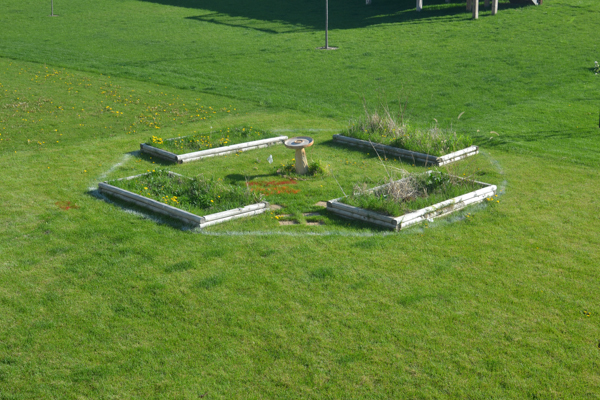
Plan The Layout Of The Paver Patio
Like I said, our new yard didn’t really have a good spot for a paver patio and fire pit. I wasn’t going to move the playset because the kids really enjoy it. The raised garden beds in the back corner of the lot though were full of grass and weeds and were a real pain to mow around. They weren’t even raised more than about 6″ out of the ground. The grass had no trouble invading them and choking out our vegetables. We weren’t attached to them and the wood was starting to rot anyway. This seemed like the best spot for the new yard focal point.
We decided to incorporate the fire pit into the paver patio so some planning and drawing had to take place. To determine the overall size of the patio we had to start in the middle with the fire pit. Menards (a midwest home improvement store) have steel fire ring kits in both 28″ and 36″ diameters. They also carried a 36″ square ring. These kits were designed to work with common sizes of landscape blocks so that it is relatively easy to build. We wanted a round ring but the larger 36″ size.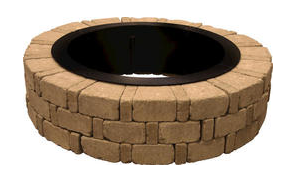
Starting with a 36″ diameter ring we also figured out the width of the landscape blocks. The blocks were 7″ wide so doubling that and adding the ring diameter gave an overall outside diameter of 50″. That’s the outside diameter of the complete fire ring. Knowing this we could start planning how much space we wanted for seating so that the chairs could sit on the pavers but could still back up far enough if we had a good size fire burning. Right around 6′ is a good amount of space from the fire ring. This leaves plenty of room for larger chairs like adirondacks as well.
If we add all this up, 6′ plus the fire ring width of 50″, plus another 6′ is 16′ 2″. The two inches isn’t a make or break deal so I rounded down to 16′. This is the overall diameter of the patio. Since we were putting it near the corner of the lot it we needed to know if the city had any setback requirements. Our lot has 4′ utility easements so that meant the patio couldn’t be within 4′ of the property line.
Call Before You Dig
 Now that we knew the setback and the dimensions of the patio we could stake it out. The first thing I did was measure in 12′ from both the side and back property lines. This number is the 4′ setback plus half the diameter of the patio (8′). I dropped a stake here and then proceeded to spray paint the perimeter of the excavation area. The excavation area is a little larger than the patio finished size. I marked out 18′ diameter.
Now that we knew the setback and the dimensions of the patio we could stake it out. The first thing I did was measure in 12′ from both the side and back property lines. This number is the 4′ setback plus half the diameter of the patio (8′). I dropped a stake here and then proceeded to spray paint the perimeter of the excavation area. The excavation area is a little larger than the patio finished size. I marked out 18′ diameter.
Marking the excavation area with white marking paint gives a clear spot for the utility companies to come and check for conflicts. I can’t stress this enough. Any time you’re going to be digging/excavating in your yard it is very important to call at least 3 days before you want to dig. In my state, MN, they say you only need 48 hours but in the middle of summer, the location services are really backed up and sometimes they need more time. It’s always better to err on the side of caution. Never dig before everyone has been there to mark!!
The image below is the status directly from the ticket from all the utility companies concerned. It’s a lot more utilities than I initially thought it would be. There are a few underground piplines in the area so that’s why there are so many gas companies listed. When everyone has marked status, it is okay to dig.
Gather Supplies
With a larger outdoor project like this, it is going to take some time to do. The less time you have to spend running around to the big box store or landscape supply is more time you can spend working on the project. In an effort to save you a little time, here’s the list of everything I needed to complete the paver patio.
- Class 5 gravel sub base (dump truck delivery)
- Washed sand paver base (available in bulk or bag)
- Vibratory Plate Compactor (rental item)
- 1″ steel pipe and 2×4 screed board
- Polyurethane Construction or Landscape Adhesive (if building a fire pit)
- Paver edging and spikes
- Pavers (Order more than you need, a round patio has more waste than square)
- Paver Set Polymeric Sand (160 lbs covered this 16′ diameter patio)
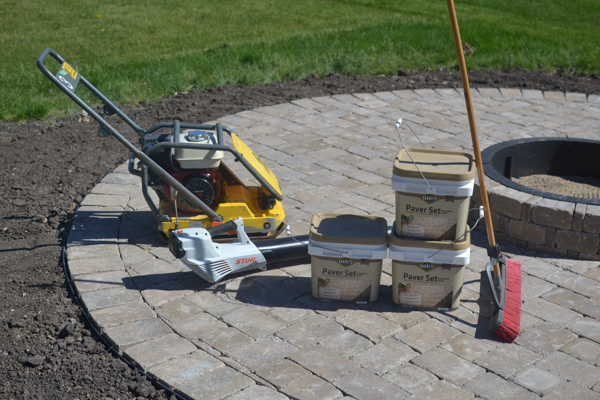
Remove The Topsoil
When it comes to a paver patio, people only see the finished product. If the patio looks good, it’s because the base was meticulously prepared. It’s definitely all about the base when it comes to a patio. The first step in the process is to remove the topsoil. Removing the topsoil does a couple things. 1.) It gets rid of the plants and organics near the surface. 2.) It gets you down to the more stable/undisturbed soils.
To remove the topsoil there are two ways to go, either do it by hand or rent a skid loader or a dingo. If your soil is loose or sandy, by hand is an easy and cheap way to go. In my area though, the soil is really thick black dirt, a skid loader was the only way to go. Even with the loader it still took the better part of the day to excavate out 9″ of black dirt.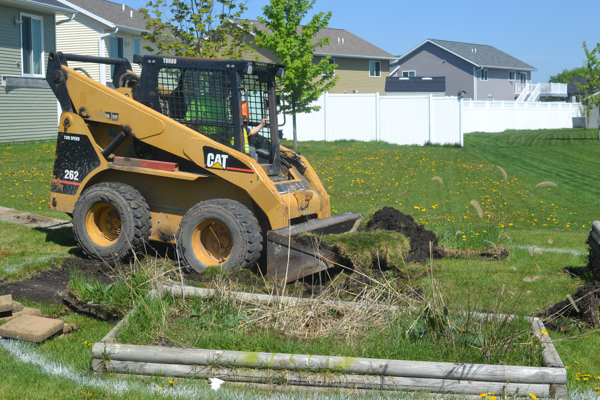
So how much dirt do you remove? Remove until you hit stable soil. I removed until I started to hit clay. The clay was far enough down that I can get in 6″ of class 5, an inch of sand, and then the 2-1/4″ pavers. Having that much dirt out will give plenty of drainage too. Being in a northern state, drainage is very important. If it doesn’t drain and then the frost comes into the ground, it will heave the patio all over the place. Drainage helps insure its longevity.
At this point, all the steps are now additive. That means that all of the removal is complete. At this stage of a paver project, I’ve heard some landscapers say to throw in landscape fabric as a weed block. When you remove 9″ of soil and have 9″ of compacted base, weeds are not the concern. If you dig out all the topsoil and the underlying soil is still unstable then you should use a geotextile fabric. This serves to isolate the patio from the surrounding soils, it helps to keep it stable.
Grade the Fill
As I said, I wanted to have roughly 6″ of sub-base for stability and drainage. So that’s roughly 3.75 cubic yards of gravel. Unless you have a big dump trailer, this fill isn’t something you can fit in your pickup. You have it delivered by dump truck.
Before filling up the hole with fill, I checked my dirt work with a laser. I’m wasn’t shooting for level in both directions, just one. This way the patio follows the natural slope of the yard and the patio will drain. The laser gives lets me know how much fill to put in. I used the Bosch GRL 500 HCK. Having a rough idea, I started filling up the hole.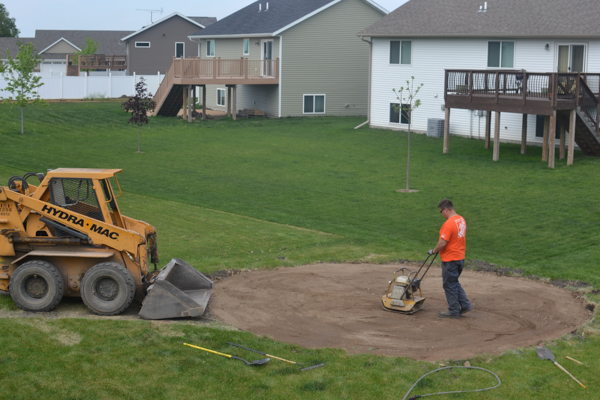
It’s important to note that the fill must be compacted. If you’re using a large plate compactor than only one lift is needed. If you’re using a small plate compactor like me, the fill must be compacted in multiple lifts. I compacted 3″ at a time.
When the hole is close to full I checked it again with the laser to see where the high and low spots are and adjusted accordingly. Once everything is hunky dory, I compacted the fill one more time.
Screed the Sand
After the fill is all graded and compacted, a uniform layer of sand is needed. The sand layer helps the pavers settle in and stabilize. To obtain a uniform layer use steel pipes 1″ in diameter. I used galvanized steel pipe but EMT is a much cheaper option at under $14 for two 10′ sticks. You will also need a long straight 2×4. The board will serve as your screed over the two pipes.
Lay the pipes on top of the compacted layer of fill parallel to each other and roughly 8′ apart. It doesn’t matter which direction you lay the pipes as long as they are parallel. Then set the 2×4 on one end of the pipes. Start filling in between the pipes with sand. Rake the sand just a little higher than the pipes. With a back a forth sawing motion across the pipes, pull the screed towards yourself down the pipes. Take small passes, the sand is heavy to pull by yourself. If the sand is quite a bit higher than the pipes, you’ll have to take multiple passes. The sawing motion helps keep the 2×4 on the pipes ensuring a uniform thickness of sand.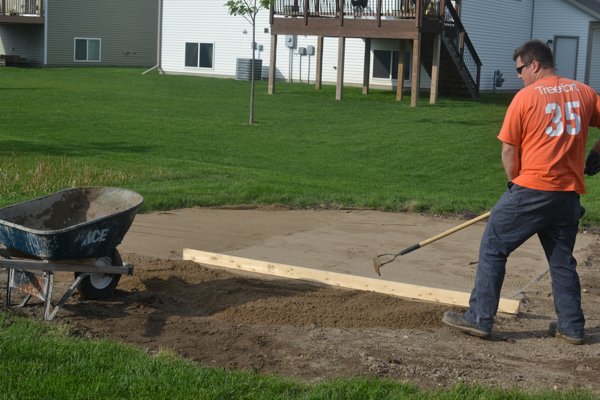
With a square patio, you start in one corner and leapfrog the pipes around until the area is filled in. With a round patio though, I screed off the sand in the center first and used that as a wet line to screed around the rest of the perimeter. When you have all of the sand placed, pull the pipes and fill in their voids with sand.
It is important to note that this layer isn’t compacted yet. It will get compacted after all the pavers have been set. Now that the sand area is set, it is important not to walk around and tear it up too much. If you do, use your push broom and a light touch to smooth it out again.
Paver Patio To Be Continued…
Now that the base is all prepared, it’s time to get to the good parts, setting the edging, laying up the fire pit, setting and fitting the pavers, and finally locking them all together with Sakrete Paver Set. I’ll show you step by step how to complete this project with tips and tricks along the way. Click the link below to continue onto part 2.
Building A Paver Patio – Part 2
This is a sponsored conversation written by me on behalf of Sakrete. The opinions and text are all mine.




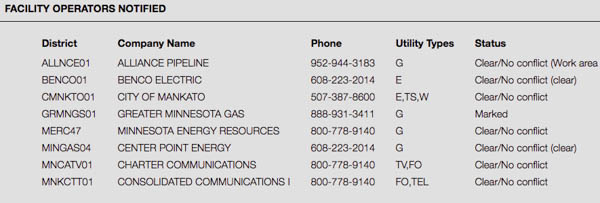









Nice suggestions. The fire pit looks cute.
It will motivate me to create one in December this year